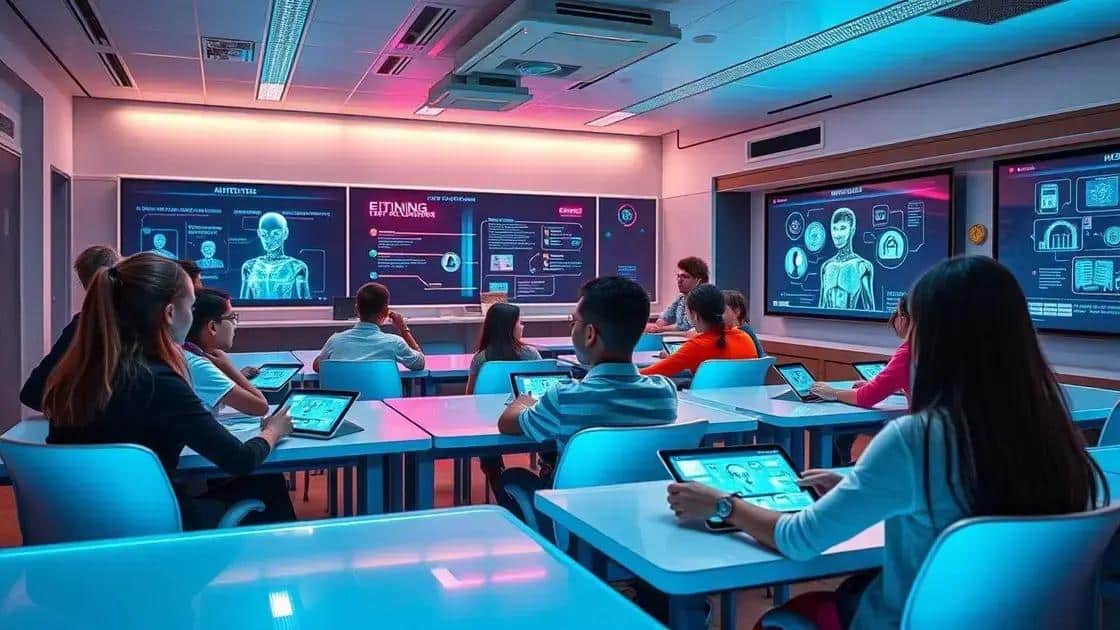Digital literacy curriculum – emerging trend for today’s learners

Digital literacy education equips students with essential skills to effectively use technology, emphasizing cybersecurity, digital citizenship, and personalized learning through artificial intelligence.
Digital literacy curriculum is becoming an essential part of education as technology evolves. Have you ever wondered how it shapes the skills of learners today? Dive in to explore its importance and benefits.
Understanding digital literacy: What it means today
Understanding digital literacy is essential in our technology-driven world. It goes beyond just being able to use a computer; it’s about navigating, evaluating, and creating information dynamically. In today’s society, digital literacy plays a vital role in how we communicate, learn, and even do business.
With the growing influence of the internet, the concept of digital literacy has evolved. It now includes various skills necessary for effective participation in digital environments. This includes the ability to responsibly consume media, engage with digital content, and utilize technology for problem-solving.
Key Skills of Digital Literacy
In modern education, several skills stand out as foundational components of digital literacy. These skills help students thrive in a digital world.
- Information Literacy: The ability to find, evaluate, and use information effectively.
- Technical Skills: Proficiency in using digital tools and platforms.
- Critical Thinking: Evaluating digital content for credibility and relevance.
- Digital Communication: Using technology to communicate clearly and effectively.
As we dive deeper into the role of digital literacy, we notice that it fosters the development of critical thinking. It encourages individuals to ask questions and analyze information rather than just accept it at face value. This growth in questioning aligns with today’s educational goals of promoting independent learning.
Furthermore, digital literacy promotes the ability to work collaboratively in online spaces. Through group projects and various online platforms, students can interact, share ideas, and solve problems together, which enhances their overall learning experience.
The challenge now lies in implementing these skills into the classroom effectively. Some educators focus on integrating digital tools into their teaching strategies. By doing so, they prepare students not only to understand technology but to use it as a tool to enhance their learning and contribute meaningfully to society.
Key components of an effective digital literacy curriculum

To create an effective digital literacy curriculum, certain key components must be included. These components ensure that students gain the skills they need to thrive in a digital world.
One essential part of the curriculum is curriculum integration. This means that digital literacy isn’t taught as a separate subject but rather woven into all areas of learning. For example, while studying science, students might research online resources or participate in virtual labs. This kind of integration makes the learning experience more relevant and practical.
Building Critical Skills
A successful digital literacy curriculum focuses on developing critical skills in students.
- Research Skills: Students learn how to find, analyze, and interpret information from various online sources.
- Media Literacy: It teaches students to critically assess the credibility of different types of media. This includes recognizing biases and understanding different perspectives.
- Digital Communication: Learning how to communicate effectively in a digital environment is vital, including understanding netiquette and the use of appropriate channels for communication.
- Problem-Solving Skills: Students should be taught to use digital tools to solve problems creatively and efficiently.
Another important aspect is the incorporation of hands-on activities. These activities provide students with opportunities to apply what they have learned in real-life scenarios. Engaging in projects that require collaboration and creativity helps deepen their understanding of technology and its applications.
Moreover, continuous assessment and feedback play a critical role in the curriculum. Regular assessments help track students’ progress and identify areas where they may need additional support. This feedback is essential for both teachers and students in adapting their learning approaches.
Challenges in implementing digital literacy programs
Implementing digital literacy programs can be challenging for many educational institutions. Various obstacles may arise, affecting the effectiveness and integration of these programs. Understanding these challenges is crucial for developing robust solutions.
One major issue is the lack of resources. Many schools struggle with limited access to technology and inadequate funding. Without proper devices or reliable internet connections, students cannot fully engage in digital literacy activities. This can hinder their learning experience and limit their exposure to essential digital skills.
Training Educators
Another challenge involves ensuring that educators are adequately prepared to teach digital literacy. Many teachers may not be familiar with the latest technology and digital tools.
- Professional Development: Schools must invest in ongoing training for teachers. This will help them stay current with digital advancements.
- Support Systems: Providing teachers with resources and support is essential for implementing effective programs.
- Collaboration: Encouraging collaboration among educators can help share best practices and improve teaching methods.
Moreover, student engagement is another significant concern. Some students may lack motivation to participate in digital literacy programs. To address this, educators should incorporate more interactive and relevant content into lessons. This can help capture students’ interests and show them the value of digital skills in their everyday lives.
Finally, measuring the success of digital literacy initiatives can be complicated. Schools need to establish clear assessment metrics to evaluate students’ progress effectively. This includes not only test scores but also practical applications of the skills learned. By setting clear goals and regularly assessing student performance, schools can adapt their programs to meet the needs of their students better.
Future trends in digital literacy education

The future of digital literacy education is rapidly evolving as technology continues to shape our world. Trends are emerging that promise to enhance learning experiences for students.
One significant trend is the integration of artificial intelligence into educational platforms. This technology can personalize learning, allowing students to progress at their own pace. AI tools can adapt lessons based on individual performance, making learning more effective and engaging.
Emphasis on Cybersecurity
Another key aspect is the growing importance of cybersecurity education. As students rely more on digital platforms, understanding how to protect personal information becomes crucial.
- Awareness Programs: Schools will implement programs that educate students about online safety and the risks associated with digital activities.
- Hands-On Training: Interactive lessons on recognizing phishing attempts and protecting privacy will become common.
- Safe Practices: Teaching best practices for password management and secure communications is essential.
Moreover, collaborative learning through technology is on the rise. Students will increasingly engage in project-based learning, utilizing digital tools to work together even when geographically apart. This prepares them for future workplaces where remote collaboration is the norm.
Another notable trend is the focus on digital citizenship. Educators will emphasize the responsibilities that come with technology use, such as respect for others online and understanding the impact of digital footprints. By instilling these values, schools will help shape responsible and informed digital citizens.
Finally, gamification in digital literacy will continue to gain traction. Incorporating game elements into learning activities can boost engagement and motivation. As students compete for rewards and recognition, they deepen their understanding of digital skills in a fun environment.
FAQ – Questions About Digital Literacy Education
What is digital literacy education?
Digital literacy education teaches students the necessary skills to effectively use technology and navigate the digital world.
Why is cybersecurity important in digital literacy?
Cybersecurity focuses on equipping students with knowledge to protect their information and be safe online.
How does artificial intelligence enhance learning?
AI personalizes the learning experience, adapting lessons to students’ individual needs and pacing.
What role does digital citizenship play in education?
Digital citizenship promotes responsible and ethical use of technology, helping students understand their impact online.





